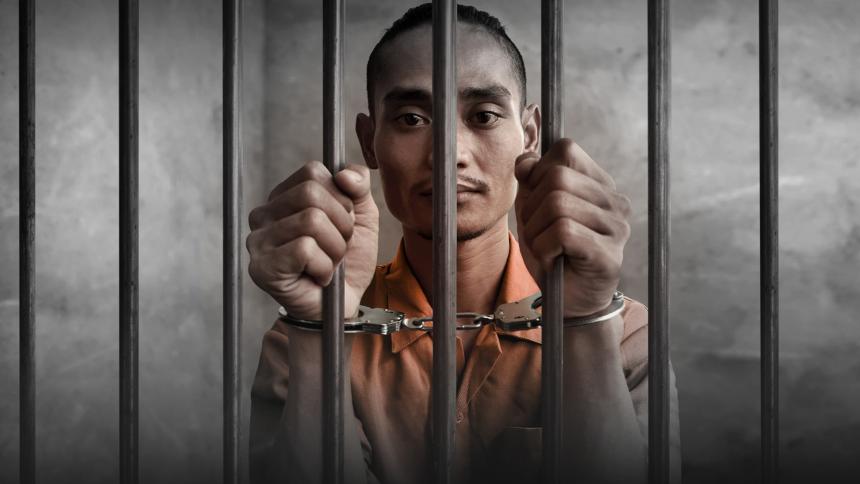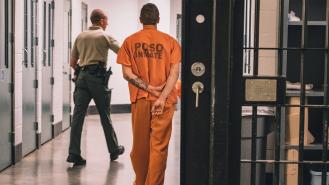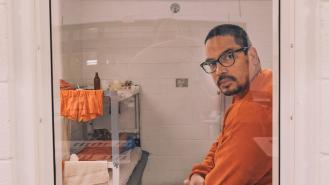
15 little known facts about '60 Days In: The Jail'
60 Days In: The Jail has one of the most audacious set-ups in the history of documentary shows. Simply put, each season sees a group of people volunteer to go undercover as convicts in a tough US jail.
Their mission? To gain first-hand insights into how well the system is functioning and what problems need addressing. Everything from drug use to corruption is on these volunteers’ radars as they try (not always successfully) to blend in with hardened criminals.
But just how does a show like this get made? Is there an incentive for correctional institutions to take part? And how are the suckers for punishment – ie, our brave and plucky participants – selected? Let’s get into it.
1. The jails get paid
One of the most often-asked questions about 60 Days In is whether the jails are compensated for allowing the volunteers and crew in. The answer is: absolutely. For example, Clark County Jail received $60,000 for providing the setting of the show’s first season. This cash was spent on improving the facilities, by way of equipment upgrades and staff training.
Jamey Noel, the Clark County sheriff, said at the time that some of the money would be earmarked for updating the jail’s camera systems, meaning that involvement in 60 Days In may have actively enhanced the safety of both prisoners and guards.
2. Finding the right participants is a big task
‘One of the most surprising things was how many folks were willing to put aside their lives for two months to participate in a program like this.’
That’s showrunner Greg Henry, discussing the 60 Days In application process in a previous interview. While the show has no shortage of willing candidates, the procedure of whittling down hundreds of applicants is a tricky one. Everyone must go through a comprehensive array of background and medical checks. The latter is important because the last thing they’d want is someone with a chronic health problem falling ill under an assumed convict name.
As Henry has said, ‘It’s months upon months of work to get it to the place we got it to, but probably the most rigorous you will find in any television show.’
3. Filming is a painstaking effort
It probably won’t come as a huge surprise to know that taking cameras into a jail and filming the words and deeds of convicted criminals is a bit of a legal minefield. Greg Henry and his team assembled a group of constitutional lawyers to have ‘hours upon hours – which equals very expensive – conversations where we were going through every point’.
What this means is that every camera shot you see on the show will have been vetted and approved beforehand by the legal advisors, with the crew having to balance out the best camera angles with ‘what the Constitution allows [them]’. Convicts and guards, believing themselves to be in a documentary about first-time offenders, sign release forms that allow their footage to be used on the show.
4. One volunteer became internet infamous
Ask any hardcore 60 Days In fan to name a controversial participant, and chances are they’ll point to Robert Holcomb. Appearing in the very first season, Holcomb was, in the words of Greg Henry ‘very touch-and-go, very minute to minute, because he went in and kind of did his own thing’.
Holcomb’s showboating behaviour aroused the suspicion of real convicts, causing him to cover a cell camera with a towel. This egregious breaking of jailhouse rules led to Holcomb being carted off to solitary confinement, effectively rendering him useless to the show and the experiment. The crew couldn’t pull Holcomb out either, since that would have raised questions among prisoners and staff.
Viewers voiced their feelings online, with Holcomb being dubbed ‘one of the worst contestants ever, but also the most memorable’.
5. It’s not always as nasty as it seems
While being banged up in a US jail is never a walk in the park, participants in the show have also spoken warmly about their fellow inmates. The notorious Robert Holcomb, for example, said that they ‘were the nicest group of people I had been around my entire life’, recalling how random acts of kindness, like the loaning of magazines and writing materials, made his experience more than bearable.
It’s certainly true to say that, in a peculiar way, 60 Days In can be genuinely feel-good viewing as well as a hard-hitting look at the American penal system.
6. The show was a passion project
Despite its sensational premise, 60 Days In wasn’t the product of some cynical brainstorming meeting by attention-hungry TV execs. Greg Henry had actually wanted to make a truly no-holds-barred documentary about jail life for some years, having already worked on previous shows about the prison system.
He always felt frustrated by the lack of honesty shown by the people he’d filmed. ‘Every time we make a series in a prison, we come away feeling like everybody that we spoke to sort of had an ulterior motive and we weren't getting a true perspective on what it was like to do time,’ he said in an interview on the genesis of 60 Days In.
‘We were getting it through the eyes of someone who had committed a crime and therefore they earned their way to where they were. Or, with correction officers, they always have their perspective on the world as well.’
By withholding the precise nature of the show to the convicts and guards, the crew can capture unfiltered insights, providing an unprecedented and unbiased look at what life is really like behind bars.
7. The jails have gained real insights from the show
60 Days In isn’t just gripping television – it’s also yielded tangible insights for the authorities who’ve dared to engage in the unprecedented experiment. For example, Clark County Sheriff Jamey Noel was shocked to learn that the inmate hierarchy dictated the smallest details of everyday life, with new arrivals expected to give pod bosses their food or other items in exchange for simply using the bathroom.
This kind of casual tyranny was a new one on Noel, who said that ‘even folks in corrections for 20-plus years had never heard of that’.
During the show’s various seasons, participants have consistently reported similar abuses, from brutal violence to sexual harassment. They’ve also confirmed suspicions that some inmates deliberately get re-arrested because drugs are easier and cheaper to get in jail than on the streets.
All of this has provided valuable wake-up calls for officers and managers and even led to reprimands and legal action against corrupt staff.
8. Actual criminals have participated
Viewers who’ve yet to enter the world of 60 Days In would be forgiven for thinking the participants are all ordinary members of the public who had to learn the ropes in double-quick time.
That was certainly the premise of the show to begin with, but a milestone moment came with season five’s cohort and the arrival of the first participant who was an ex-con. Reformed gang member Abner was, by his own accounts, once a terrifying presence on the streets and someone you’d ‘cross the road’ to avoid.
Season seven went further, with every participant being a former convict. One was Carlos, who did time for criminal possession of a weapon. He turned his life around while serving that stretch and was stabbed 12 times after making the brave decision to leave his gang.
9. Prisoners are known to create their own ‘courts’
If you’ve never seen 60 Days In, chances are you won’t know that criminals have set up their own makeshift ‘courts’ in their cells. Thanks to the show, we’ve been able to see these surreal kangaroo courts in action and it’s a fascinating insight into the unexpectedly formal power structures and codes of conduct in US jails.
In one episode, participant Ryan watched as a ‘tribunal’ of criminals summoned an inmate called Mingus. His alleged crime was using too much of someone’s e-cigarette, and proceedings against him commenced with another inmate bellowing: ‘Order in the court!’
Following testimonies from witnesses, Mingus was solemnly pronounced guilty and sentenced to a beating.
10. Some legal authorities must be kept in the dark
There’s no denying that 60 Days In is a highly risky endeavour. Hardened criminals are deceived on a daily basis and participants put themselves in harm’s way to glean insider information – an endeavour that could have them swiftly labelled 'snitches', with potentially violent consequences.
But it’s not just the inmates who need to be ‘played’ just right by the production team. The legal authorities beyond the jailhouse walls must also be kept in the dark to ensure the participants can maintain their cover stories. This led to serious concern when season one’s Zac was called to appear in court.
This took the production team by surprise, given that Zac’s jail journey had originated in a TV production office rather than a courtroom. It turned out that, by incredible coincidence, there was another inmate with Zac’s exact name in the very same jail, and the wrong Zac had been given the court summons.
This put the production team in a seemingly impossible situation: they couldn’t just refuse the summons, given that it was officially ordained by a judge, but if Zac appeared in court his cover would be well and truly blown.
Fortunately, prison officers realised there had been a calamitous mix-up just in time to stop the court transfer, but the whole incident was a reminder of the precarious position of the brave participants.
11. Some of the participants are 60 Days In superfans
When 60 Days In first aired it was a new kind of show, with the initial volunteers having no examples to follow and no idea what they’d let themselves in for. Even season two’s participants had no option but to wing it since their run was actually filmed before the first season aired.
But the show has become a cultural phenomenon since then and some of the later participants have admitted to being 60 Days In ‘superfans’. This includes Mark from season five, who was an avid watcher of the programme and a former corrections officer. Season six’s Alex and Ashley also boasted about seeing every single episode of the show.
12. A murder plot was uncovered during filming
During filming of the third season at Fulton County Jail in Atlanta, prison staff stumbled across a truly shocking plan to have one of the prison guards murdered.
The staff had decided to intercept and scrutinise a letter from a troublesome inmate, suspicious that he may be trying to orchestrate crimes outside of the prison walls. Their suspicions were justified when one letter contained encrypted and coded messages telling someone on the outside to kill a guard.
Because of the sensitivity of the incident, security at the jail and the fact that none of the principal participants were directly involved in the plot, the tale didn’t make it into any of the episodes.
13. Some participants had been on television before
With the incredible amount of thought, time and preparation that goes into the production of the show, it simply has to go to plan. One minor oversight or mistake can unravel the whole thing if an inmate recognises one of their fake peers. This is why it’s always hazardous when producers throw someone in jail who’s been on television before.
Robert Holcomb had previously appeared on TLC’s Extreme Time Cheaters and Tami Ferraiuolo (Tami Ferguson) had been on TruTV’s Caught Red Handed and New York Ink. And that’s just from series one. Over the next seven seasons, participants came from a range of backgrounds, including the potentially recognisable faces of former college football players and podcasters.
14. The crew use an incredible number of cameras
The exact number of secret cameras that are installed in the jail will depend on the size of the place and how the producers and director decide to approach each season.
However, as a general rule of thumb, there will have been a minimum of 75 microphones and approximately 300 cameras installed, all running 24 hours a day, seven days a week.
15. Muhammed Ali’s daughter took part
If you’re not a 60 Days In superfan you might not know that Muhammed Ali’s eldest daughter, Maryam Ali, was in series one.
She went in with an alias, calling herself Yasmin Brown. A social worker and public speaker, Maryam managed to keep her true identity under wraps for the duration of filming.
The debut series was filmed at the Clark County Jail in Jeffersonville, Indiana which isn't far from Maryum's famous father's birthplace of Louisville, Kentucky. This almost caused an issue one evening during filming when the local news ran a story on her boxer dad while she was in earshot of the TV.












